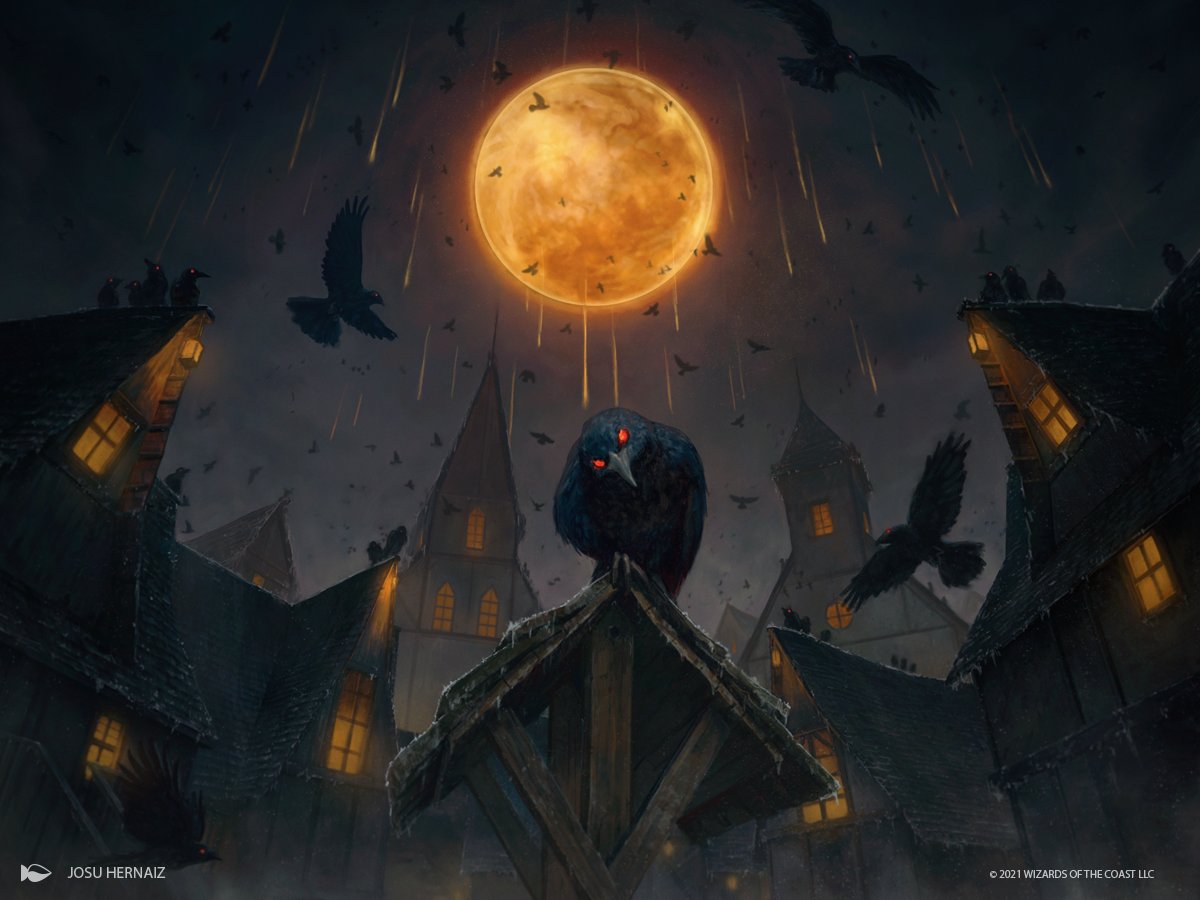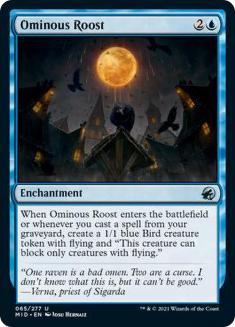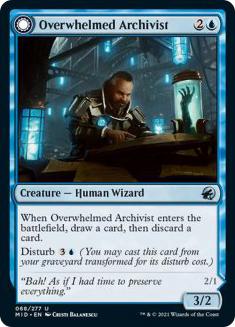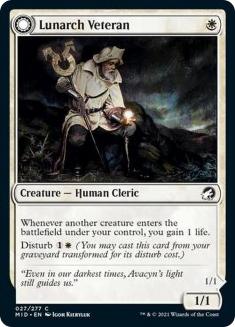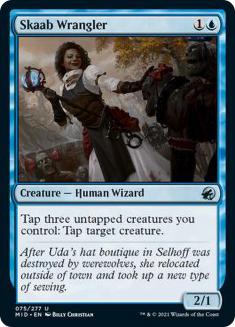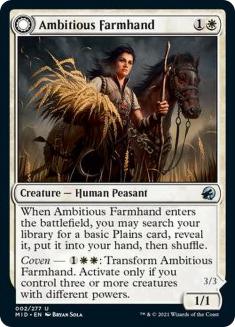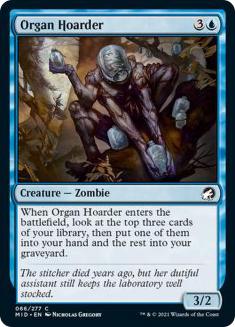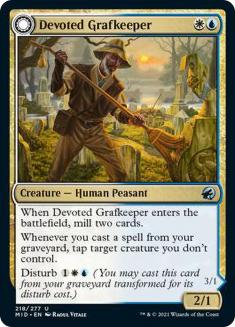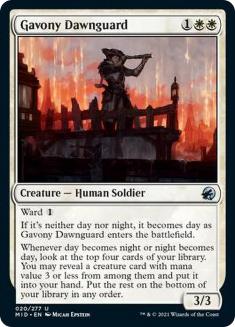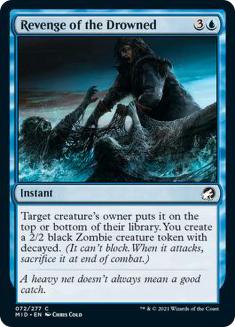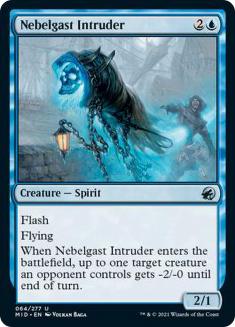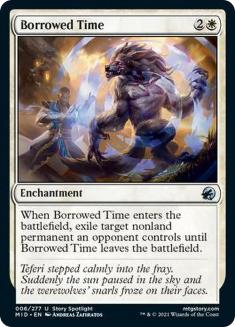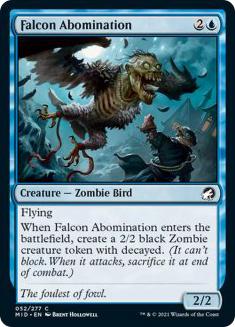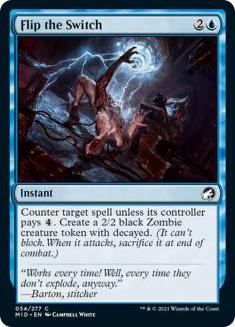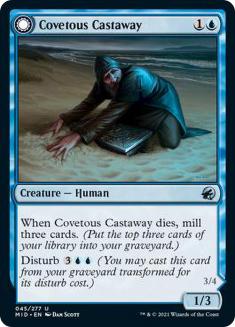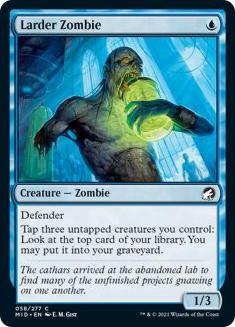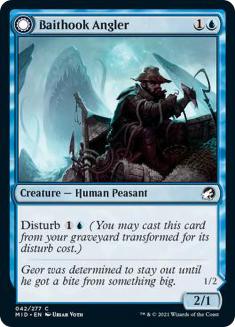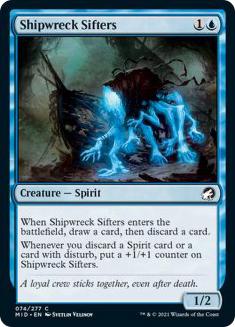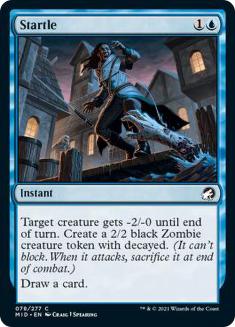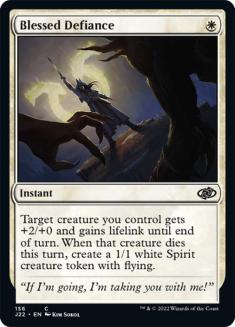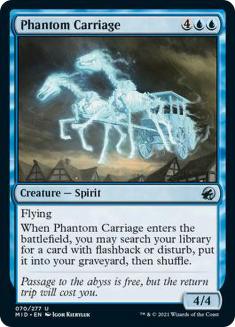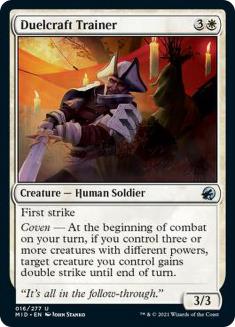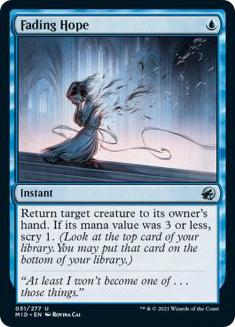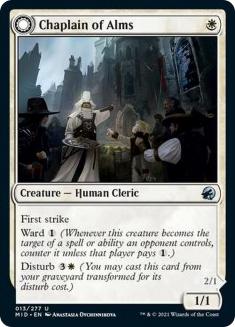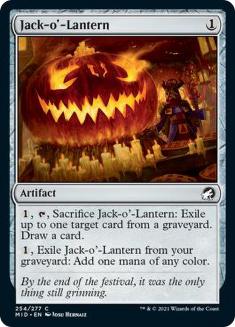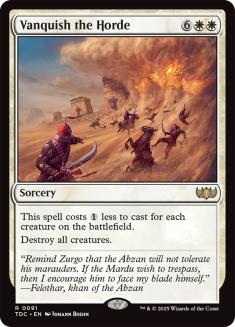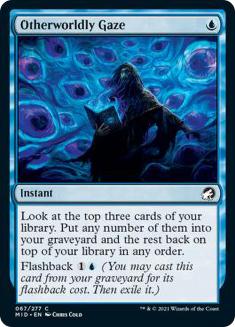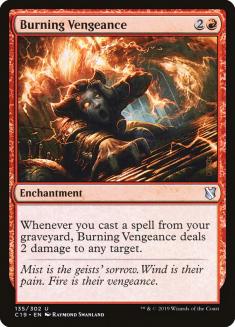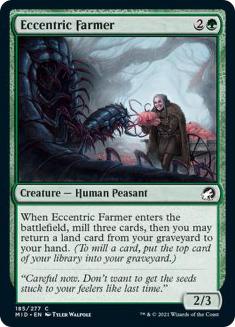According to 17lands.com, Azorius has been the most successful color pair in Innistrad: Midnight Hunt Premier Draft by .7%, which is actually a pretty large amount. Is it the strongest color pair? That’s actually hard to evaluate, because it’s played less than half as much as Dimir, so players might only win more because the archetype is less contested. But if it’s the most successful deck, that strongly suggests that it’s currently being underdrafted, meaning you should probably draft it more.
I’ve taken this advice to heart, and I’ve drafted Azorius in six of my last eight and four of my last four drafts, to a record of 27-4 in my last 4, and 36-8 in my last six Azorius decks. This is to say that my personal experience supports the assertion that Azorius is the best deck to be drafting on Arena at the moment.
Why is Azorius so strong?
Two weeks ago, I wrote about how the format was driven by the strength of removal. This paradigm works perfectly for Azorius, because removal doesn’t line up well against any of the cards you want, since you’re looking for creatures that cost less mana than most removal spells that kill them, offer some kind of value when they enter the battlefield or die, or, in many cases, both. I’m always drawn to decks whose core strength is resilience, and that describes Azorius in this Limited format perfectly. In most of my games, it just doesn’t feel like any of my opponent’s cards matter because they don’t line up well with what I’m doing.
The best Azorius decks have the lowest curves in the format. They go under other decks, but use the graveyard so well that they simultaneously have great late-games and don’t run out of gas. This might sound somewhat unfair, or like it would be the kind of balance issue that designers would try not to print, at which point, I’d agree, but suggest that we’re here anyway.
We know that this deck wins the most, I’m just unpacking why.
There are a few different sub archetypes of Azorius, but any of them are strong, and I don’t think it relies on any particular card. Honestly, the most important common might be Lunarch Veteran, because the easiest way to lose is against an aggressive opponent who can beat you before you can out value them because their early creatures just beat yours in combat, such as Boros or Rakdos, and Lunarch Veteran stops those decks from going under you.
Top Tier Commons and Uncommons to Draft Early
(presented roughly in order of priority)
This card is just the total package. It’s a good rate for its stats, offers card advantage if you can discard something you can cast from your graveyard, and offers value itself when you mill it. This can play every role you want a creature for, so it’s a safe pick that’s always what you’re looking for.
It feels weird to choose “disrespecting Organ Hoarder” as my spot to go against the stats, but I think Lunarch Veteran should be the highest priority common in Azorius. I discussed why it’s important in the metagame above, but I also just find that I can always build my Azorius decks to have plenty of ways to use their mana, so Organ Hoarder is more replaceable. For a lot of the best builds of Azorius decks, I want to maximize the value of dumping a card in the graveyard, and Lunarch Veteran as the huge advantage that it’s such a card. It’s also by far the most important card to pair with Ominous Roost, since it gives you time to take over with your flying army.
There are a lot of cards with higher win rates than Ominous Roost, but I’m reasonably confident that’s because people aren’t properly building their decks to maximize Ominous Roost, and it’s felt much higher impact than other cards in my decks that are built to use it. It’s also bad in all but the most dedicated decks, which means it’s not often picked by other drafters, especially if you’re taking the cards that enable it, meaning that if you get one early it’s not that unlikely that you’ll get a second.
Azorius is great because it makes lots of cheap creatures. Skaab Wrangler makes sure you won’t lose games to fewer bigger creatures.
This is just such a clean value card, and a 3/3 lifelink is a huge body in this format.
I’m not going to make the mistake of disrespecting Organ Hoarder too much, and I don’t want to give the impression that it isn’t amazing. Between the card selection and the self mill value, this ability is very close to as strong as drawing two cards in this deck. I want four to be roughly the top of my curve most of the time, but as long as I can avoid playing many other expensive cards, I’m happy to play as many Organ Hoarders as I can get my hands on.
This is just the total package, offering a discounted, slightly weaker, but overall very similar card to Overwhelmed Archivsit.
Some builds of Azorius want to have low creature counts, and might correspondingly prioritize Gavony Dawnguard less highly, but a 3/3 with ward for three mana and a terrifying threat of activation that can force your opponent to play their spells differently is just a great rate regardless of how reliably it finds a creature when you trigger it.
This has felt like the only removal spell I need, and it’s great because it’s so reliable. It doesn’t answer a creature forever, but it’s always felt like it answers creatures for as long as I need.
Two-power flyers are a great clock for this deck, and I’ve gotten card advantage one way or another when I’ve played this a pretty great portion of the time. It also plays very well with Flip the Switch, since you can hold your mana up and make a play if your opponent doesn’t play something you want to counter.
This is the cleanest answer you’ll find in these colors, but I prioritize it a little below its actual win rate because I just don’t think these decks really need to worry that much about their opponent’s cards, and I’d rather focus more on my own synergies.
I value Zombie tokens pretty highly; the damage they offer is important for finishing games, but not as important as their utility with Skaab Wrangler or Larder Zombie, both of which I prioritize highly. The 2/2 flyer is one of the best ways to start clocking the opponent.
This is a great piece of interaction while you’re ahead, and since I want to play a lot of one and two-mana creatures, Azorius is an ideal deck for the card.
This is a deck that wants to play a lot of cheap creatures, and prioritizes evasion and cards that generate value, so this basically has to be good.
Second Tier Commons and Uncommons
(These are cards that I don’t want in some decks, want in limited numbers, or want, but think are narrow enough that I’ll often pass them to try to table them)
The disturb cost on this is very expensive, but the body you get is worth it, and this is a fine cheap play if I don’t have anything else to do early, though I’d rather put it straight into my graveyard if I can.
I want to end up with exactly two Larder Zombies, and they’re often passed late, so exactly how highly I prioritize these will shift more highly than most cards throughout the draft as a function of how late we are in the draft and how many I already have. If I’m in Pack 3 and I don’t have any yet, I’ll take it over most top tier cards. Larder Zombie is absolutely amazing in this archetype.
The choice between Shipwreck Sifters and Baithook Angler is a hard one. Shipwreck Sifters is more powerful, but its power depends on having enough disturb creatures, and Baithook Angler is a great nuts and bolts card for the deck that makes most of your other cards better. Ultimately, I like enough other cards whose strength scales based on how many Baithook Anglers I have that I’ll typically take Baithook Angler as a higher priority.
Shipwreck Sifters is still great. If you have enough disturb cards that you’ll generally be able to discard one, this does a great job of protecting you in the early-game to make sure you stay alive if you don’t have Lunarch Veteran, and the more Shipwreck Sifters you have, the better each becomes (provided you also have a lot of disturb creatures).
I love Startle. The only reason I’m not higher on it is that I really want to prioritize the graveyard synergies in Azorius, since all the mill and card that want to be milled have multiplicative implications on each others power level, while Startle is just doing its own thing, it can get pushed to the back burner a little, but I’m always happy to play it.
Blessed Defiance actually has a higher win rate than most of my top tier of commons and uncommons, ahead of cards like Borrowed Time and Skaab Wrangler, but there’s just no way I can prioritize a card that’s taken around 10th pick on average that highly. I’ve played it quite a bit. It can easily swing a game against an aggressive red deck, and it’s pretty easy to get reasonably value out of it either by just trading up anywhere or simply using it to turn a decayed Zombie into a Spirit and a life swing. There are a lot of matchups where it’s somewhat underwhelming, but it’s at its best in some of the scariest matchups, so I’m still happy to play one or two.
Other Notable Commons and Uncommons
This is a good effect, but six is just so much mana. I’d prefer to build my deck to avoid that.
This is another card that’s very powerful, and it offers a way to break through or end a game that Azorius is often looking for, but there are simply more good four-mana spells than I really want to put in my deck, and this gives my opponent something useful to do with their Silver Bolts and other removal spells, which make me feel less exploitable if I just don’t prioritize this.
A nice tempo spell, but it kind of falls into the same trap as Startle, where I’d rather focus on synergy, and I like Startle more because it more directly draws me to my synergistic cards.
This is more similar to Baithook Angler than it is to Lunarch Veteran, and I value it a little lower because the disturb cost is so high, but this is still a very high priority in Shipwreck Sifter builds.
I like to pick these up whenever there isn’t another priority to let me splash something if I want. Particularly if you’re a version of the deck that wants Otherworldly Gaze (most often because you have Ominous Roost), then a few Jack-o’-Lantern can make a splash very easy.
Above is the baseline. These are the cards you should prioritize early in the draft as you’re finding your way into an Azorius lane, but as I said, there are a number of different kind of decks you can end up in when you’re drafting Azorius, and as you start to figure out which you are, you’ll change your priorities considerably.
As the title of this article indicates, the version I want to focus on is how you should change gears when you get Ominous Roost. When you have Ominous Roost, you want as many of your other cards as possible to have disturb, flashback, or to put cards in your graveyard. Should you be worried about drafting around it too much and not finding your Ominous Roost? I don’t think so. Otherworldly Gaze, Larder Zombie, Organ Hoarder, and Faithful Mending are all great graveyard enablers and all of them give you the option to keep any card you see rather than putting it in the graveyard. This set has very little blind self mill, meaning the mill that’s happening it digging you to the cards you’re looking for, so the deck is very good at finding its Ominous Roost, and, likely just because I’ve been a little lucky, whenever I’ve taken an Ominous Roost early enough to draft around it, I’ve ended up getting another later. Even if that doesn’t happen, worst case, you’ll still have drafted a deck where most of your cards work together.
This is also a deck that uses any bomb, including a splashed bomb very well for the same reason it uses Ominous Roost well, you’ll just see a ton of cards every game, so if you have a good card, you’ll see it more than most decks. When I had a Vanquish the Horde in a deck like this, it was absolutely amazing.
You want to draft in such a way that Otherworldly Gaze becomes one of the top 5 commons for you, but you generally still don’t want to take it over another card you’d like for your deck because you can generally table it. There’s no limit to the number I’m looking for in a good Roost deck.
Everything that’s not part of the plan moves down, everything that is part of the plan moves up, when it looks like it’s all coming together, my prioritization of commons and uncommons looks something like this (assuming I can’t table anything, if you suspect you can table a card, you should take a lower card over it):
- Ominous Roost
- Lunarch Veteran
- Skaab Wrangler
- Overwhelmed Archivist
- Otherworldly Gaze
- Devoted Grafkeeper
- Organ Hoarder
- Jack-o’-Lantern*
- Faithful Mending
- Larder Zombie*
- Shipwreck Sifters
- Covetous Castaway
- Baithook Angler
- Chaplain of Alms
- Ambitious Farmhand
- Revenge of the Drowned
- Homestead Courage
- Beloved Beggar
- Delver of Secrets*
- Nebelghast Intruder
- Falcon Ambomination
- Gavony Dawnguard
- Startle
- Devious Cover-Up*
- Mourning Patrol
- Search Party Captain
- Flip the Switch
- Mysterious Tome
- Blessed Defiance
- Borrowed Time
- Gavony Trapper
- Galedrifter
- Gavony Silversmith
- Secrets of the Key
- Geistwave
- Consider
*=This is roughly as high as I’d take this in the right conditions. Delver will be a function of how many instants and sorceries I’m playing, Jack-o’-Lantern is only if I’m splashing something important, and I only want two Larder Zombies or Devious Cover-Ups.
As you can see, this is a pretty big shift from how things are prioritized in other builds of Azorius. A good Ominous Roost deck can spend a lot of the game casting more than one spell from the graveyard each turn, which is why Otherworldly Gaze and cards that are cheap to play from the graveyard are so important.
I’ve been asked if this is “this format’s Spider Spawning,” and no, this is this format’s Burning Vengeance, but that deck doesn’t seem to be as fondly remembered. Regardless, you can’t draft as if you’re this deck before you know you are this deck, you have to start by following the conventional prioritization while tracking how many of the graveyard cards you’re seeing and noting whether they’re all coming back. The more you have, especially with Roost, the more you can shift toward this list, but you want to transition your priorities gradually to avoid a trainwreck. The great thing about drafting this way is that it’s very safe. You should still take bombs because you can splash them, and you’re mostly prioritizing strong, flexible blue cards, so it’s easy to pivot into another blue deck if white isn’t open, or another Azorius deck if you don’t see the graveyard cards.
There is a Bant version of this deck that incorporates Eccentric Farmer. It’s a little more dangerous because your Farmers might mill your Roosts, but you can mitigate that risk if you get Dryad’s Revival. You might want to prioritize creatures over flashback spells in that build to enable Tapping at the Window and Deathbonnet Sprout. You’ll want to be careful with green flashback cards because many of them are very expensive, and you really don’t want your deck to get too clunky.
You can splash any great cards, particularly if they only cost a single off-color mana, and I haven’t included any in this list. Cards with flashback are obviously particularly high priorities. I can say from experience that Slogurk, the Overslime is an amazing splash.
Finally, here are some samples of what you should be looking for when drafting around Ominous Roost from my own drafts:



